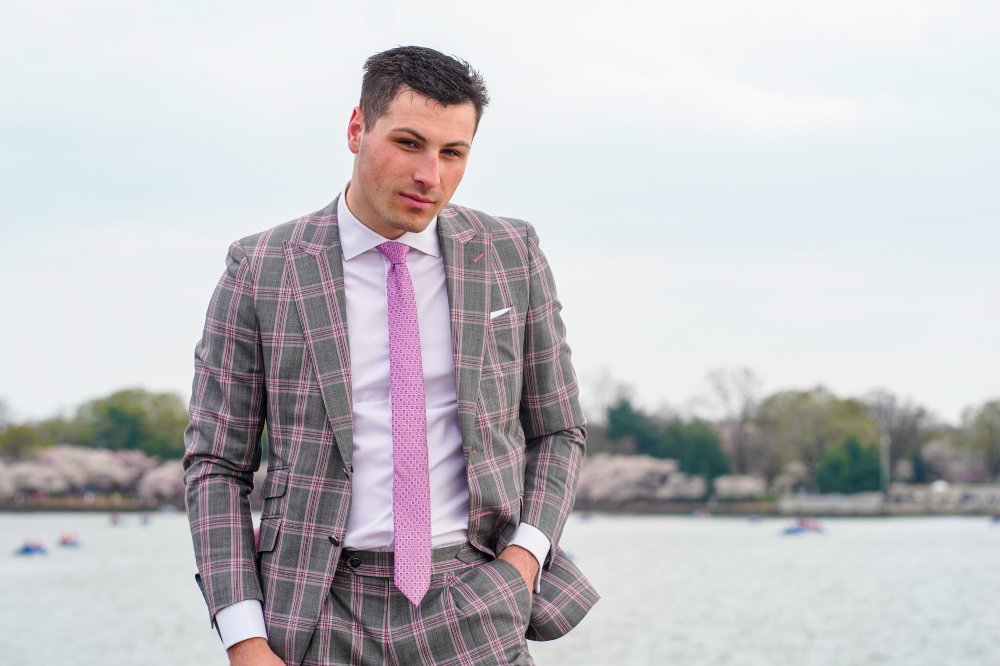Culture
 Casey Rowe. Photo by Andrew J. Williams III.
Casey Rowe. Photo by Andrew J. Williams III.
Designer Casey Rowe on Building a Name in Fashion
February 27, 2024 @ 2:00pm
The custom designer talks tailoring, the fashion industry and the value of a well-fitting suit.
We are spotlighting the myriad voices redefining what it means to be stylish in the nation’s capital — from designers and stylists to entrepreneurs and athletes whose unique stories and perspectives shape bold visions. Check out our full Curators of Style roundup in the May issue here.
At 23 years old, Casey Rowe is already a respected voice in high-fashion spaces. As a partner at Christopher Schafer Clothier, he dresses celebrities, trailblazers, military generals and titans of industry. Though, Rowe’s journey is anything but traditional. After a major injury derailed his athletic career in high school, upending his college plans, he eschewed higher education for an unpaid internship with an up-and-coming custom suit tailor in Baltimore. Now, he’s charged with guiding the brand’s second location in D.C.’s eclectic and iconic Adams Morgan neighborhood. We caught up with Rowe to discuss his career in tailoring, including Christopher Schafer’s nonprofit side, and finding a career that fits.
District Fray: What inspired you to pursue a career in suit tailoring?
Casey Rowe: I really love art: painting, drawing, interior design and putting things together. I was in a fashion and textile program in high school that was two years long — one of the only ones left in the country. It was very extensive; I did a fashion show towards the end of my career there. A girl walked up to me after the show and said, “Do you have any plans to pursue this? You should call this guy — his name is Christopher Schafer. He works down in Baltimore. I think you’d be really good at this.”
What was your first impression of Christopher Schafer’s shop?
The second I walked in, I fell in love. I remember the shop like it was yesterday: the loft space, the plants, the well-dressed mannequins, the bolts of fabric. My eyes got so big. I did my interview and was told, “Why don’t you show up on this date, at this time, at this place and we’ll go from there.” The place I was told to show up at was Sharp Dressed Man, our nonprofit. We dress guys for interviews for free. It’s a really beautiful environment. You’re meeting guys who are down on their luck. That taught me what well-tailored, well-designed clothing can do for somebody. That [transitioned] into my interning at Christopher Shafer Clothier. I worked for free, and I wore my Jos. A. Bank suit, which was my brother’s and two sizes too big. I showed up early every day I was told to be there. I shut my mouth, took notes and assembled a notebook that I still carry with me to this day.
What other lessons about the industry did you learn in those early days?
I was working with people who were powerhouses in their industry. I had to learn from a young age how to talk to these people, how to interact with them and how to blow someone away — customer service at the highest level. I took that role very seriously. I needed to make it my college experience. It was a grind the first year. There were a lot of people above me killing it. I got to learn from them what to do, and I got to learn a lot of what not to do. [Eventually] it was just Chris and me. At 19 years old, about to turn 20, I was thrown into running a $3,500 custom suit shop.
Did you embrace the weight of that responsibility?
The part I really grabbed onto and made my [own] was the design process: the two and a half hours I get to spend with somebody and walk them through everything that goes into what we do. I learned from somebody who learned how to make clothes on Savile Row in London at the Mecca of menswear. I’m not a well-traveled person. I really had to figure out what my niche was. It was the [art] of breaking down a garment, [and] explaining to somebody how a garment is built: what goes into it, why it is priced accordingly. If you walk into a department store, you’re not going to get that. It’s a very transactional experience. I like to think [a tailored suit] is an heirloom.
How important is individual style to the tailoring process?
Everybody’s personal style is different. I would never put something on somebody that is not intuitive. I’ve worked with plenty of people in the past who have very unique styles that suits don’t fit into. I don’t think the only form of high dress for men is a suit. But do I think every man should have a well-tailored suit in his wardrobe? Absolutely.
Check out Rowe’s many suit styles on Instagram @casey.rowe.
Christopher Schafer Clothier: 1794 Columbia Rd. #6, NW, DC; christopherschafer.com // @christopherschafer
Want insight on the best local guides and creators to follow? Join the District Fray community for exclusive access to content made and curated by some of the coolest D.C. residents. Become a member and support local journalism today.
Original post date: May 1, 2023 @ 2:00pm







